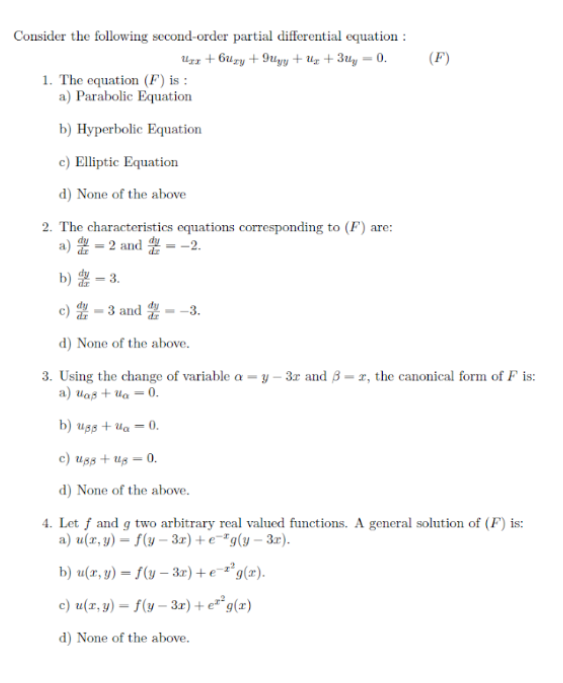Consider the following second-order partial differential equation : Uzz + 6uzy + 9tiyy + Uz + 3u, = 0. (F) 1. The equation (F) is : a) Parabolic Equation b) Hyperbolic Equation c) Elliptic Equation d) None of the above 2. The characteristics equations corresponding to (F) are: a) 2 – 2 and - -2. b) - 3. c) - 3 and - -3. d) None of the above. 3. Using the change of variable a = y – 3r and 3 = z, the canonical form of F is: a) Mas + Ha = 0. b) ugs + Ua = 0. c) Uss + Ug = 0. d) None of the above. 4. Let f and g two arbitrary real valued functions. A general solution of (F) is: a) u(x, y) – S(y – 3r)+e~*g(y – 3r). b) u(r, y) = f(y – 3r) +e~²°g(z). c) u(x, y) = f(y – 3r) + e**g(x) d) None of the above.
Consider the following second-order partial differential equation : Uzz + 6uzy + 9tiyy + Uz + 3u, = 0. (F) 1. The equation (F) is : a) Parabolic Equation b) Hyperbolic Equation c) Elliptic Equation d) None of the above 2. The characteristics equations corresponding to (F) are: a) 2 – 2 and - -2. b) - 3. c) - 3 and - -3. d) None of the above. 3. Using the change of variable a = y – 3r and 3 = z, the canonical form of F is: a) Mas + Ha = 0. b) ugs + Ua = 0. c) Uss + Ug = 0. d) None of the above. 4. Let f and g two arbitrary real valued functions. A general solution of (F) is: a) u(x, y) – S(y – 3r)+e~*g(y – 3r). b) u(r, y) = f(y – 3r) +e~²°g(z). c) u(x, y) = f(y – 3r) + e**g(x) d) None of the above.
Advanced Engineering Mathematics
10th Edition
ISBN:9780470458365
Author:Erwin Kreyszig
Publisher:Erwin Kreyszig
Chapter2: Second-order Linear Odes
Section: Chapter Questions
Problem 1RQ
Related questions
Question
Partial differential equation second degree

Transcribed Image Text:Consider the following second-order partial differential equation :
Uzz + 6uzy + 9uyy + Uz + 3uy = 0.
(F)
1. The equation (F) is :
a) Parabolic Equation
b) Hyperbolic Equation
c) Elliptic Equation
d) None of the above
2. The characteristics equations corresponding to (F) are:
a) - 2 and = -2.
b) = 3.
c) - 3 and - -3.
d) None of the above.
3. Using the change of variable a = y – 3r and 3= r, the canonical form of F is:
a) uaß + Ua = 0.
b) ugs + Ua = 0.
c) uss + Ug = 0.
d) None of the above.
4. Let f and g two arbitrary real valued functions. A general solution of (F) is:
a) u(x, y) = f(y – 3r) +e¯*g(y – 3r).
b) u(r, y) = f(y – 3r) +e¯²°g(x).
c) u(x, y) = f(y – 3r)+e**g(x)
d) None of the above.
Expert Solution
This question has been solved!
Explore an expertly crafted, step-by-step solution for a thorough understanding of key concepts.
This is a popular solution!
Trending now
This is a popular solution!
Step by step
Solved in 3 steps

Recommended textbooks for you

Advanced Engineering Mathematics
Advanced Math
ISBN:
9780470458365
Author:
Erwin Kreyszig
Publisher:
Wiley, John & Sons, Incorporated

Numerical Methods for Engineers
Advanced Math
ISBN:
9780073397924
Author:
Steven C. Chapra Dr., Raymond P. Canale
Publisher:
McGraw-Hill Education

Introductory Mathematics for Engineering Applicat…
Advanced Math
ISBN:
9781118141809
Author:
Nathan Klingbeil
Publisher:
WILEY

Advanced Engineering Mathematics
Advanced Math
ISBN:
9780470458365
Author:
Erwin Kreyszig
Publisher:
Wiley, John & Sons, Incorporated

Numerical Methods for Engineers
Advanced Math
ISBN:
9780073397924
Author:
Steven C. Chapra Dr., Raymond P. Canale
Publisher:
McGraw-Hill Education

Introductory Mathematics for Engineering Applicat…
Advanced Math
ISBN:
9781118141809
Author:
Nathan Klingbeil
Publisher:
WILEY

Mathematics For Machine Technology
Advanced Math
ISBN:
9781337798310
Author:
Peterson, John.
Publisher:
Cengage Learning,

